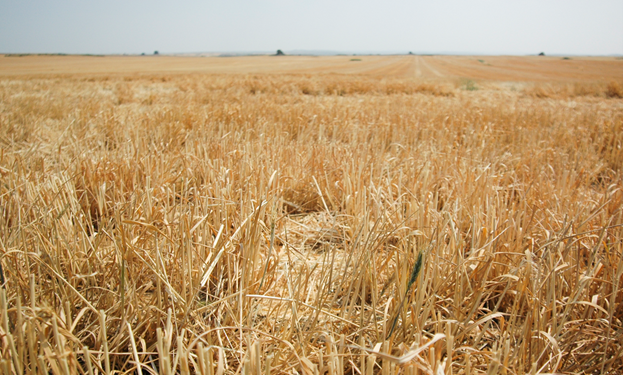July 27, 2023
Permission to republish original opeds and cartoons granted.
As Russia cuts off Odesa and Ukraine’s wheat export capacity, U.S. failed to produce any more wheat in 2022

By Robert Romano
After Russia halted a deal to allow Ukraine to export wheat from certain locations on the Black Sea, and has resumed bombing of Odesa, Ukraine’s ability to export grain is once again being degraded — an outcome entirely predictable from the onset of Russia’s invasion of Ukraine in Feb. 2022 — but the United States has failed to boost wheat production since then.
According to BBC’s Ukraine correspondent James Waterhouse, “The Kremlin had earlier agreed not to target port infrastructure in three locations in the region, but that diplomatic shield is no more. With damaged ports, no agreed corridor through the Black Sea and Russia controlling most of the coastline, [Kernel CEO Yevhen] Osypov believes Ukraine's grain export capacity will drop by a further 50%.”
In 2021, prior to the war, global wheat production was about 772 million tons, 75 million of that came from Russia and another 33 million tons came from Ukraine. Then, Ukraine was exporting about 16 million metric tons of wheat, but last year that was down to about 13.5 million metric tons, but that was with the grain deal in effect. No longer.
258 million people were at increased risk for starvation in 2022, according to the United Nations’ (UN) “Global Report on Food Crises 2023,” up from 193 million in 2021, a 33.6 percent increase, following Russia’s invasion.
To offset the losses, a May 12 report from the U.S. Department of Agriculture, “World Agricultural Supply and Demand Estimates,” also confirms boosts in productions elsewhere to offset the production losses out of Russia and Ukraine, including in Argentina and Canada: “The global wheat outlook for 2023/24 is for lower supplies, trade, consumption, and ending stocks compared with 2022/23. Global production is forecast at a record 789.8 million tons, up 1.5 million. Larger crops in several countries, including Argentina, Canada, China, the EU, and India are partly offset by sizeable declines in Australia, Russia, Ukraine, and Kazakhstan. The largest increase is for Argentina, where production is expected to recover from a significant drought. Near-record production is forecast in Canada on expanded area reported in the Statistics Canada planting intentions survey. EU production is forecast higher, benefiting from above-average precipitation for nearly all EU member countries except Spain and Portugal… After three consecutive record crops, production in Australia is forecast to decrease substantially as yields revert to average.”
As for Russia and Ukraine, production will continue to be lower than what it was prior to the war, according to the USDA: “Production in Russia is forecast lower on reduced area and yields from last year’s record. In Ukraine, production is forecast down 21 percent from the prior year, mostly due to the war with Russia.”
U.S. wheat production is down 15 percent since 2019, from 1.93 billion bushels in 2019 to 1.64 billion in 2021, according to data compiled by the U.S. Department of Agriculture. In 2022, it was no better, coming in at 1.65 billion bushels.
Overall, the U.S. produces a little more than half of what it did in 1981, when it produced more than 75 million metric tons of wheat. That was down to 44.9 million in 2022.
The reason simply is we don’t plant as much land as we used to. In 1981, we planted on 88 million acres, but that is down to about 45 million acres, according to the Department. Half the land, half the wheat. Simple.

In the meantime, the federal government continues to pay farmers not to farm on some 22 million acres of farmlands that are a part of the voluntary Conservation Reserve Program, established in 1985 to address soil erosion and other environmental impacts caused by farming.
Despite the tens of millions of acres that could be utilized at this critical moment, the Biden administration USDA is still looking to expand the Conservation Reserve Program, according to a Feb. 16 news release: “Agriculture Secretary Tom Vilsack announced that agricultural producers and private landowners can begin applying for the Conservation Reserve Program (CRP) General signup starting February 27 through April 7, 2023. CRP is a cornerstone voluntary conservation program offered by the U.S. Department of Agriculture (USDA) and a key tool in the Biden-Harris administration’s effort to address climate change and help agricultural communities invest in the long-term well-being of their land and natural resources.”
Is fighting climate change or saving birds via these land conservation programs more important than fighting potential global starvation? If we were reserving this land in case of a crisis, haven’t we found that crisis?
On May 11, 2022, President Joe Biden promised that U.S. farmers were “expanding production and feeding the world in need” and pushed for “double-cropping,” a practice where wheat and other crops are planted twice without cultivating new land. It didn’t work. In part that was due to the weather, as yields fell in 2022, but if the U.S. really wants to boost production, more land is the ticket.
Robert Romano is the Vice President of Public Policy at Americans for Limited Government Foundation.
To view online: https://dailytorch.com/2023/07/as-russia-cuts-off-odesa-and-ukraines-wheat-export-capacity-u-s-failed-to-produce-any-more-wheat-in-2022/
Video: Have We Reached Peak Wokeness? Corporate America ditching Chief Diversity Officers.

To view online: https://www.youtube.com/watch?v=f8EFdyPHOHM
Video: Hunter Biden Just Received Horrible News

To view online: https://www.youtube.com/watch?v=m9eMrnTsHto
Video: Hunter Biden Shenanigans EXPOSED

To view online: https://www.youtube.com/watch?v=YQIceeOlE5c
